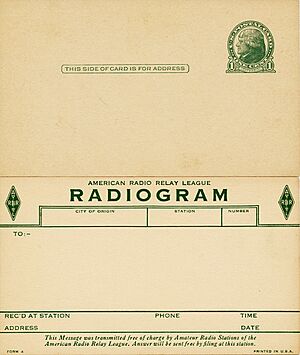Radiogram (message) facts for kids
A radiogram is an official written message sent using radio waves. Think of it as a formal text message or email from the time before the internet. It is also called a radio telegram.
Radiograms have a special, organized format. This structure helped radio operators send messages quickly and clearly, especially when radio channels were busy. They were used by ship captains, soldiers, and even hobbyist radio operators to send important information. Because they were written down, radiograms created a record of the communication, a bit like a saved email.
Contents
From Wires to Wireless Waves
Before radio, people sent long-distance messages called telegrams using the electric telegraph. An operator would tap out a message in Morse code, which traveled as electrical pulses through long wires to another city.
The Invention of Radio Messages
Around the year 1900, inventors like Guglielmo Marconi figured out how to send telegraph signals through the air using radio waves. This was called radiotelegraphy, or "wireless telegraphy." Now, messages could be sent across oceans or to ships at sea without needing giant underwater cables. These new wireless messages were called radiograms.
Why Did Radiograms Have Special Rules?
Sending a message by radio wasn't like sending a text today. Radio channels could get very crowded, so every second counted. To make sure messages were understood perfectly, radiograms followed a strict format.
A typical radiogram included:
- From: Who sent the message.
- To: Who the message was for.
- Date and Time: When the message was sent.
- Precedence: A code to show how important the message was. For example, an "emergency" message would be handled before a "routine" one.
- The Message Text: The actual information being sent.
This organized system made sure that the most urgent information got through first and nothing was misunderstood.
Radiograms in Action
Different groups used radiograms for very important jobs.
Military Messages
Armies and navies around the world relied on radiograms to send orders and reports. Because these messages were so important, military radiograms had a very strict format, sometimes called the 16-line message format. Every line had a specific purpose, so there was no confusion.
One of the most famous military radiograms in history was a message sent to warn about the attack on Pearl Harbor in 1941 during World War II. This shows how vital radio messages were for national events.
Messages for Radio Hobbyists
Today, amateur radio operators (also called "ham radio" operators) still use radiograms. They have a network called the National Traffic System (NTS) to pass messages for practice or fun.
During a natural disaster, when phones and the internet might not work, these skilled volunteers can use their radios to send important messages for emergency services or for people trying to contact their families. Their system is run by the American Radio Relay League (ARRL).
Modern Radiograms: Sending Data by Radio
Even in the age of the internet, people have found new uses for radiogram technology.
From 2012 to 2017, a program called VOA Radiogram experimented with sending digital information over shortwave radio. Using a simple radio and free computer software, people could receive text and even images broadcast from thousands of miles away.
The main broadcast mode used was MFSK32, which turns data into a series of musical tones. The official VOA program ended in 2017, but the idea lived on. A new program called "Shortwave Radiogram" was created to continue broadcasting digital text and images for radio fans around the world.


